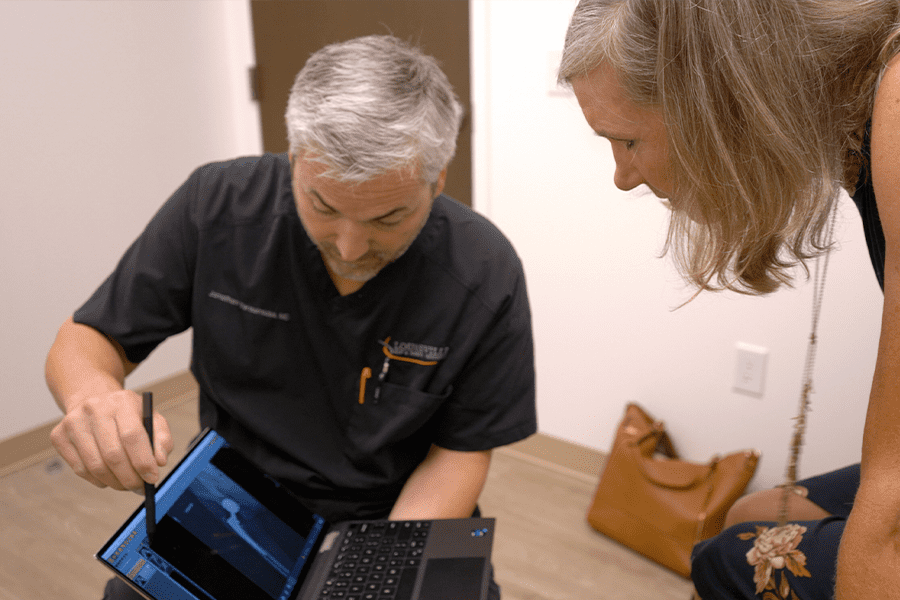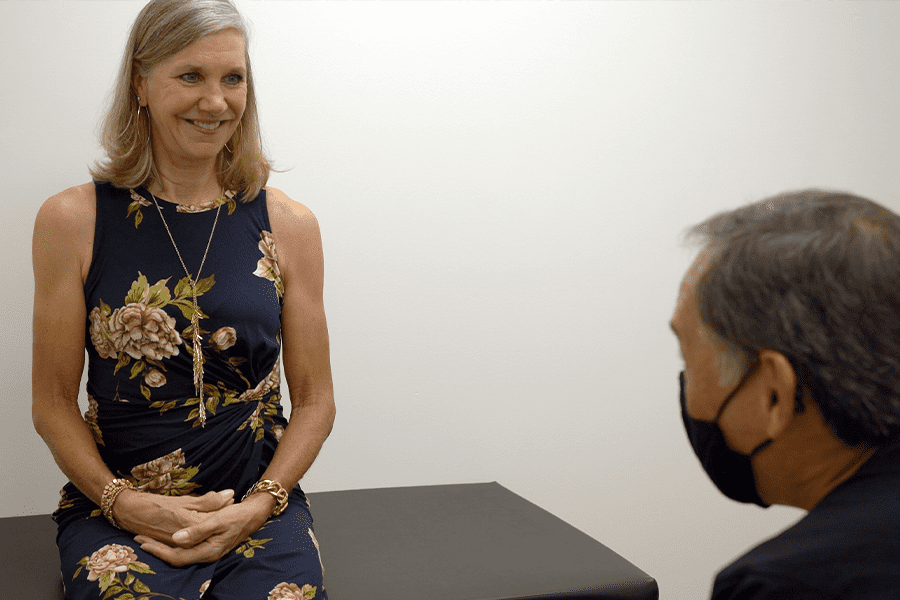- What is total hip replacement?
- Why would I need total hip replacement?
- What is recovery like after a total hip replacement?
- What are the benefits of total hip replacement for athletes?
If you’re an athlete, hip replacement just comes with the territory. Arnold Schwarzenegger had a total hip replacement. Three-time Grand Slam tennis champion Andy Murry had a similar procedure. Fitness guru Jane Fonda underwent two hip replacements.
Athletes put pressure on their bodies and expect a great return from their muscles and joints. Over time, intense workouts can cause debilitating pain. Total hip replacement is one of the most common and most successful ways to remedy that pain and restore mobility to a worn out joint.
Tracy T. is a competitive cyclist who had a total right hip replacement with Jonathan G. Yerasimides, M.D., board-certified orthopedic surgeon at the Louisville Hip & Knee Institute. She says, “The biggest benefit that I’ve noticed is not having any pain.”
What was it like for Tracy to undergo total hip replacement? Was she able to regain her mobility and get back to the sport she loves?
What Is a Total Hip Replacement?
 A total hip replacement is a surgery that removes a worn out or damaged hip joint and replaces it with a prosthetic, or human-made, hip. During the procedure, your doctor will remove the ball and socket joint and replace it with metal, plastic, and ceramic component parts.
A total hip replacement is a surgery that removes a worn out or damaged hip joint and replaces it with a prosthetic, or human-made, hip. During the procedure, your doctor will remove the ball and socket joint and replace it with metal, plastic, and ceramic component parts.
High impact sports place strain on the joints. The hip joint supports your entire body weight, and can suffer from excessive wear and tear as well as repetitive injury from the movement of pedaling. Like most athletes, Tracy was taught no pain no gain—and fought through the aches for years. She says, “I’m a very active person and a competitive cyclist. One of the things I’ve noticed is after I get off my bike, I’m not limping around like I had been for a year or two before that.”
The hip joint is the largest ball and socket joint in the body. The socket of the joint is called the acetabulum, and it rests in the pelvis at the core of your body. The ball is the head of the upper thigh bone, or femur. These two bone parts come together to allow rotation of the hips, standing, and movement. Holding the ball and socket together are bands of connective tissue (ligaments, tendons, muscles) and cartilage that cushion the ball and socket where they rub together.
There is also a thin membrane that surrounds the joint which makes a tiny bit of fluid to keep things lubricated. All of these complex parts do a great job helping your body move the way you need it. However, each of these complex parts make the joint quite complex and prone to wear out over time.
Why Would I Need Total Hip Replacement?
 Damage to the hip joint frequently leads to osteoarthritis, an inflammatory condition that attacks the body. Around 50% of older adults say they suffer from joint pain. Hip replacement’s primary goal is to alleviate that pain and remove the stiffness that comes from arthritis, bone spurs and other issues that stem from a bad or worn down hip joint. Accident damage or the constant wear and tear of athletics can all contribute to a condition where stiffness and soreness is a constant battle.
Damage to the hip joint frequently leads to osteoarthritis, an inflammatory condition that attacks the body. Around 50% of older adults say they suffer from joint pain. Hip replacement’s primary goal is to alleviate that pain and remove the stiffness that comes from arthritis, bone spurs and other issues that stem from a bad or worn down hip joint. Accident damage or the constant wear and tear of athletics can all contribute to a condition where stiffness and soreness is a constant battle.
Hip pain can be debilitating. Even simple activities such as tying your shoes or getting out of a chair require the proper functioning of your hip joints. Many times, the pain grows so bad, even sleep is affected. If you’re considering total hip replacement, you probably experience:
- Pain that keeps you from doing even everyday tasks, such as walking or bending
- Pain that keeps you up at night
- Stiffness that keeps you from moving the way you want to
- Over-the-counter pain relief no longer helps
- Other non-invasive treatments, like prescription medications or physical therapy don’t work anymore
If you’re experiencing these daily struggles, Tracy has some advice for you. She says, “Surgery is a very scary thing to embark upon if you’ve never had it before. I’m really glad I decided to do it.”
What Is Recovery Like After a Total Hip Replacement?
 The first astonishing thing to note about total hip replacement, is that it can often be performed in an ambulatory outpatient surgery setting. Tracy says, “The fact that you can go home the same day is remarkable.” While not all patients qualify for same-day total hip surgery, Tracy was a great candidate for this procedure.
The first astonishing thing to note about total hip replacement, is that it can often be performed in an ambulatory outpatient surgery setting. Tracy says, “The fact that you can go home the same day is remarkable.” While not all patients qualify for same-day total hip surgery, Tracy was a great candidate for this procedure.
Everyone’s recovery journey from hip replacement is different, but key to a successful process is your willingness to follow your orthopedic surgeons after care instructions. After a total hip replacement, you will be encouraged to walk and move even before you leave the surgery center. You will be instructed to perform strengthening exercises during your recovery to help improve blood flow and muscle tone. Your therapy team will help you gradually build up to movement in ways that cause you the least amount of discomfort possible.
By the third or fourth day following total hip replacement, most patients are using a cane. By 2 weeks after surgery, you should be able to walk without a cane. Walking is the best form of therapy you can do for a hip replacement. It’s okay to use a stationary bike if you’d like, but keep the resistance low. Aggressive exercise within the first month will only cause additional swelling and pain and not make your recovery any faster. Do not work out or play sports in the first 6 weeks after surgery. Time is needed for swelling and inflammation to resolve and for bone to grow onto the implants. After 6 weeks, you can return to activities like golf, yoga, pilates and low impact workouts. If you want to return to high impact activities like running, basketball, volleyball and skiing, wait until 3 months after surgery. By that time the implants are solidly healed to bone and able to take any stresses you want to deliver to them. Your full recovery from that point can take 3-6 months particularly if you were athletic before the procedure.
What Are the Benefits of Total Hip Replacement for Athletes?
Because Tracy was in such great shape, her recovery accelerated. She says, “Dr. Y. was completely spot-on. I was back on my bike six weeks later. Everything that he said was going to happen, has happened and it’s been perfect.”
Tracy says, “If somebody’s on the fence about getting a hip replacement—which I can completely understand—I’m a nurse, and it’s an invasive procedure.” She continues, “My advice is to get it done. There’s no point in waiting. “Everyone I’ve ever talked to says ‘I wish I hadn’t waited.’”
If you’re considering hip replacement, Tracy has this to share, “Dr. Y. is wonderful. He and his team are fantastic. They will take good care of you and you will be amazed with how much better you feel.”

